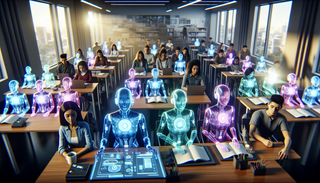
A once-in-a-generation rewrite of the lesson plan
When ChatGPT rocketed into public consciousness eighteen months ago, most headlines fixated on homework cheating. Yet beneath the panic, a quieter revolution was gathering pace: artificial intelligence was starting to re-architect the very fabric of teaching and learning. Pilot projects on three continents now show that cheap, large-language-model infrastructure can generate adaptive exercises, spoken feedback and even on-demand concept videos in seconds. As ministries of education scramble to update curricula, the prospect of a truly personalised classroom—one that learns each learner—has shifted from speculative TED talk to procurement roadmap.
Why the urgency?
Two political moves sharpened global attention this spring. First, Estonia announced free access to GPT-style tools for every secondary student and teacher, effectively treating AI literacy as a civic right. Weeks later the United Arab Emirates unveiled an AI curriculum that starts at age four, taught alongside numeracy and phonics. These decisions reframed AI not as an optional add-on but as a foundational layer, akin to reading or coding. Countries fearful of a skills gap are moving fast; 96 percent of U.S. public-school teachers surveyed by EdSurge now believe AI will be “intrinsic” within a decade, yet only a third feel prepared to use it.
Personalisation goes mainstream
The headline promise is adaptive learning at national scale. Instead of a one-size-fits-all textbook, a language model can remix the same concept at five reading levels, add interactive quizzes tuned to yesterday’s performance and switch the worked example from football to anime depending on a learner’s stated interests. Early data from an Estonian pilot reported a 22 percent increase in student engagement time when lessons were auto-differentiated in this way. Crucially, the cost curve has collapsed: what once required years of platform engineering can now be prototyped by a single teacher in an afternoon prompt-engineering session.
Accessibility superpowers
Students with disabilities may benefit most dramatically. Vision-impaired learners can request instant alt-text explanations of diagrams; dyslexic students can summon real-time phonetic breakdowns; non-verbal pupils can interact with a speech-synthesis avatar that matches their preferred communication style. Where traditional assistive technologies were siloed and expensive, AI-driven tools ride on the same consumer GPUs that power gaming PCs. Chicago Public Schools, for example, has begun trialling voice-controlled worksheet generators that convert any PDF into an interactive format compliant with screen readers—no specialist vendor required.
The cheat-code dilemma
Of course, opportunity comes bundled with risk. Axios reports that 90 percent of U.S. college students have already used AI for graded work. Detection software is locked in a Sisyphean arms race, and blanket bans push usage underground rather than eliminating it. Forward-thinking institutions are instead redesigning assessment: oral defences, practical projects and “open-AI” exams that grade the prompt, the reasoning chain and the reflection on model errors. The message is clear: using a tool is not the problem; failing to demonstrate judgement is.
Teachers in the loop
The most advanced deployments treat AI as a co-pilot, not a replacement. Finnish maths teacher Minna Saarinen spends her Friday planning period asking a model to generate dozen-levelled problem sets, then manually reviews the output, tweaking distractors and scaffolding. The time saved is reinvested in one-to-one tutoring. Meanwhile principals use aggregated, privacy-preserving dashboards to spot classwide misconceptions in near real-time. This “human-in-command” pattern flips the narrative that automation de-skills the profession; instead it elevates teachers into designers, editors and data interpreters.
Open questions for 2025
- Governance: Who owns the countless micro-datasets generated by student interactions, and how are they secured?
- Equity: Will affluent districts gain an innovation lead if cheap cloud credits still require robust broadband and device fleets?
- Quality control: How do we audit hallucination rates when content is generated on the fly?
- Pedagogy: Might over-personalisation erode the shared cultural canon that binds a classroom community?
- Workforce: As ed-tech firms like Chegg downsize, what new roles—AI curriculum architect, prompt librarian—will emerge?
None of these questions has a settled answer, but the trajectory is unmistakeable: AI is moving from pilot to default. The challenge for policymakers and practitioners is to channel the momentum toward richer, fairer, more engaging learning rather than faster, cheaper worksheets. History suggests the window is short; once infrastructure ossifies, retrofitting ethics is far harder.
Humanity’s oldest knowledge technology is still the conversation. If we can harness synthetic intelligence to make that conversation more inclusive and responsive—while keeping teachers firmly at the centre—we might finally deliver on a century-old dream: education tailored to every mind at the moment of need.
Sources
- UAE to introduce AI classes for children as young as four – Financial Times
- Teachers believe AI is here to stay in education – EdSurge